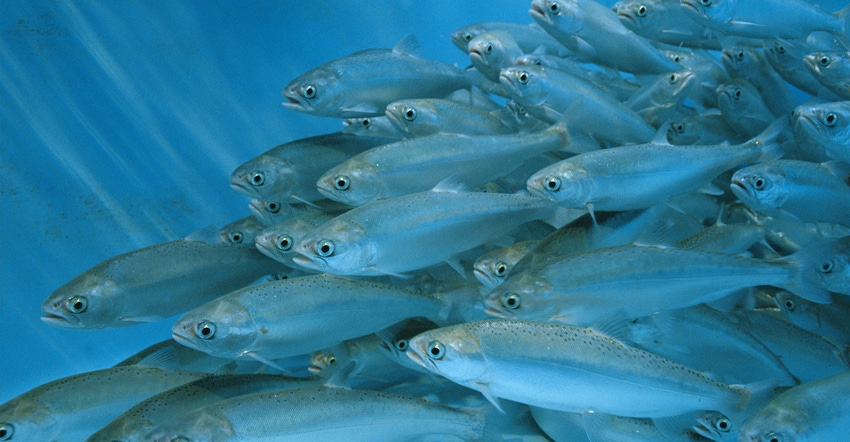January 11, 2022

“Blue foods” are protein sources derived from aquacultural sources such as fish, mussels, aquatic plants and algae. Blue foods were recently recognized in LinkedIn’s article “29 big ideas that will change our world in 2022.” As the global population continues to increase and climate change threatens current food production, blue foods are quickly becoming a key solution for meeting the high demands of an already stretched food supply chain.
How does U.S. soy fit into that? The U.S. soybean industry has long supported the growth of aquaculture as a preferred feed ingredient. The superior value and performance of soy aquafeed has helped aquaculture to meet global nutritional needs, as an affordable and sustainable means of rapidly grown protein for human nutrition.
Through sustainable farming, innovation and efficiency, U.S. soybean farmers consistently produce more essential nutrients, at a higher quality and with a better return, while using fewer finite natural resources.
Aquaculture in spotlight
Shakuntala Haraksingh Thilsted, 2021 World Food Prize laureate, pioneered fish-based food systems to improve nutrition, health and livelihoods for millions around the world.
Thilsted was the first to establish that many small fish species commonly eaten across Southeast Asia are a critical source of essential micronutrients and fatty acids, and can improve the absorption of nutrients in plant-based foods, reshaping scientific understanding of the benefits of fish in human diets. This breakthrough has helped prioritize increases in fish consumption and production, transforming the diets of some of the world’s most vulnerable people.
Thilsted’s work has directly impacted outcomes for soy organizations focused on global diets, including the U.S. Soybean Export Council and the World Initiative for Soy in Human Health, with support from the soy checkoff.
“Food security is a major issue in the developing and emerging economies where WISHH works,” says Liz Hare, executive director of WISHH. “Soy-based feed for aquaculture can be a part of the solution to get more affordable protein to more people. It’s exciting to see U.S. soybean growers engage on this issue.”
Soybean meal is a key protein source for the aquaculture and aquafeed industries worldwide due to its protein content, balanced amino acid profile and high level of digestibility for most cultured fish and shrimp species. As such, it can replace high-cost animal proteins and yield optimal fish growth. Many aquaculture diets now contain 25% to 30% soy.
2 groups lead way
WISHH and the U.S. Soybean Export Council provide a one-two punch when it comes to marketing U.S. soy around the world. WISHH specializes in developing and emerging markets, where there are currently no U.S. soy exports or very few. The organization also looks at the significance of potential growth. WISHH has made positive impacts in countries such as Tanzania, Nigeria and Cambodia.
USSEC specializes in more developed markets, including China, Thailand and Ecuador, and in growing markets such as the Middle East and North Africa.
“The U.S. soy industry has strategically created different trade organizations to focus on markets by development status to ultimately reach our goal of maximizing value for soy exports,” says Courtney Knupp, USSEC director of aquaculture and animal nutrition meal.
Both WISHH and USSEC see a potential for U.S. soy in an expanding aquaculture industry around the world.
“Aquaculture is a growing industry,” Knupp says. “U.S. soy provides a sustainable and abundant nutritional source of protein to meet the needs of many species in all major regions. That’s a huge benefit for an industry which is predicted to continue rapid growth.”
About 3.3 billion people rely on seafood for almost 20% of their protein, making it the world’s largest traded food commodity. The amount of seafood produced by aquaculture now exceeds wild catch. Total fish production is expected to expand from 179 million metric tons in 2018 to 204 MMT in 2030, according to the Food and Agriculture Organization of the United Nations. Aquaculture consumption increased 122% from 1990 to 2018, and production is projected to reach 109 million tons in 2030, reports FAO.
Power of checkoff
The soy checkoff is used for global marketing, training and information exchange for both organizations. Through the use of new technology, such as in-pond raceway systems and feed formulation advances, aquaculture continues to provide an important protein source for growing countries.
“U.S. soy-optimized feed is part of that picture because it helps with efficiency, and it’s a sustainable source for the nutritional requirements of these animals that they feed,” Knupp says. “We can build value change so that every farmer in any market is getting paid the right price, and they can manage their feed cost.”
Recently, USSEC’s Global Aquaculture Industry Advisory Council convened with fresh multistakeholder representation from 11 organizations in academia, civil society, industry, public sector and sustainability certification around the world, thereby reaffirming U.S. soy farmers’ and industry’s commitment to shaping a growing and sustainable aquaculture industry.
“Success for U.S. soy is that we see continued growth in aquaculture,” Knupp says. “And that U.S. soy-optimized feed is part of that growth because it is the sustainable source for nutritional requirements of fish and seafood worldwide.”
Learn more about how U.S. soy supports sustainable blue foods here.
Source: United Soybean Board, which is responsible for the information provided and is wholly owned by the source. Informa Business Media and its subsidiaries aren't responsible for any of the content contained in this information asset.
Read more about:
AquacultureAbout the Author(s)
You May Also Like




